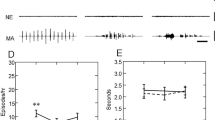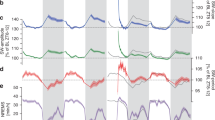Abstract
Investigation of sleep spindles’ oscillations is increasingly considered as a major avenue of inquiry in analyzing the microarchitecture of sleep. Previous studies highlight a strong mutual interaction between sleep and stress. In the present study, we investigated the effects of multiple stresses, provoked by animal immobilization in the narrow Plexiglas boxes with additional stress by placing some stones on the floor. Male Wistar rats (n = 14) were subjected to 2 h of immobilization per day in a narrow, uneven and stony place for 3 consecutive days. The electroencephalogram (EEG) was recorded with stainless steel screw electrodes placed over the skull and the electromyogram (EMG) was recorded from dorsal neck muscles. The sleep stages were recorded during 2 h before and 2 h after stress exposure for 3 days. Apart from sleep stages’ variations, sleep spindles’ density as well as their time- and frequency-domain characteristics were investigated rigorously by a semi-automatic sleep scoring method developed in MATLAB. Results indicate that multiple stresses containing immobilization as well as physical stress attenuate rapid eye movement sleep (REM). However, the stress effect on spindles is more sophisticated in NREM stages. Although spindle density does not undergo a significant change, spindle amplitude and sigma power of EEG during spindles raised significantly. Besides, a decrease in the mean frequency of spindles depicts a dramatic multiplication in delta slow oscillations. An especially mixed immobility including psychological and physical stress which we applied could affect sleep stability through an alteration in the sleep spindles’ amplitude and frequency but not the density of spindles and also through a reduction in REM sleep.





Similar content being viewed by others
References
Marks GA, Roffwarg HP. Spontaneous activity in the thalamic reticular nucleus during the sleep/wake cycle of the freely-moving rat. Brain Res. 1993;623:241–8. www.ncbi.nlm.nih.gov/pubmed/8221106.
Steriade M, Domich L, Oakson G. Reticularis thalami neurons revisited: activity changes during shifts in states of vigilance. J Neurosci. 1986;6:68–81. www.ncbi.nlm.nih.gov/pubmed/3944624.
Weiner OM, Dang-Vu TT. Spindle oscillations in sleep disorders: a systematic review. Neural Plast. 2016;2016:7328725. https://doi.org/10.1155/2016/7328725. www.ncbi.nlm.nih.gov/pubmed/27034850.
Mrdalj J, Pallesen S, Milde AM, Jellestad FK, Murison R, Ursin R, et al. Early and later life stress alter brain activity and sleep in rats. PLoS One. 2013;8:e69923. https://doi.org/10.1371/journal.pone.0069923. www.ncbi.nlm.nih.gov/pubmed/23922857.
Astori S, Wimmer RD, Luthi A. Manipulating sleep spindles—expanding views on sleep, memory, and disease. Trends Neurosci. 2013;36:738–48. https://doi.org/10.1016/j.tins.2013.10.001. www.ncbi.nlm.nih.gov/pubmed/24210901.
Fogel SM, Smith CT. The function of the sleep spindle: a physiological index of intelligence and a mechanism for sleep-dependent memory consolidation. Neurosci Biobehav Rev. 2011;35:1154–65. https://doi.org/10.1016/j.neubiorev.2010.12.003. www.ncbi.nlm.nih.gov/pubmed/21167865.
Rauchs G, Schabus M, Parapatics S, Bertran F, Clochon P, Hot P, et al. Is there a link between sleep changes and memory in Alzheimer’s disease? Neuroreport. 2008;19:1159–62. https://doi.org/10.1097/WNR.0b013e32830867c4. www.ncbi.nlm.nih.gov/pubmed/18596620.
Van Reeth O, Weibel L, Spiegel K, Leproult R, Dugovic C, Maccari S. Physiology of sleep (review)—interactions between stress and sleep: from basic research to clinical situations. Sleep Med Rev. 2000;4:201–19.
Machida M, Yang L, Wellman LL, Sanford LD. Effects of stressor predictability on escape learning and sleep in mice. Sleep. 2013;36:421–30. https://doi.org/10.5665/sleep.2464. www.ncbi.nlm.nih.gov/pubmed/23449731.
Xing B, Liu P, Jiang WH, Liu F, Zhang H, Cao GF, et al. Effects of immobilization stress on emotional behaviors in dopamine D3 receptor knockout mice. Behav Brain Res. 2013;243:261–6. https://doi.org/10.1016/j.bbr.2013.01.019. www.ncbi.nlm.nih.gov/pubmed/23357086.
Wood GE, Norris EH, Waters E, Stoldt JT, McEwen BS. Chronic immobilization stress alters aspects of emotionality and associative learning in the rat. Behav Neurosci. 2008;122:282–92. https://doi.org/10.1037/0735-7044.122.2.282. www.ncbi.nlm.nih.gov/pubmed/18410168.
Rampin C, Cespuglio R, Chastrette N, Jouvet M. Immobilisation stress induces a paradoxical sleep rebound in rat. Neurosci Lett. 1991;126:113–8.
Gonzalez MM, Debilly G, Valatx JL, Jouvet M. Sleep increase after immobilization stress: role of the noradrenergic locus coeruleus system in the rat. Neurosci Lett. 1995;202:5–8. www.ncbi.nlm.nih.gov/pubmed/8787817.
Bonnet C, Marinesco S, Debilly G, Kovalzon V, Cespuglio R. Influence of a 1-h immobilization stress on sleep and CLIP (ACTH(18–39)) brain contents in adrenalectomized rats. Brain Res. 2000;853:323–9. www.ncbi.nlm.nih.gov/pubmed/10640630.
Marinesco S, Bonnet C, Cespuglio R. Influence of stress duration on the sleep rebound induced by immobilization in the rat: a possible role for corticosterone. Neuroscience. 1999;92:921–33. www.ncbi.nlm.nih.gov/pubmed/10426533.
Papale L, Andersen M, Antunes I, Alvarenga T, Tufik S. Sleep pattern in rats under different stress modalities. Brain Res. 2005;1060:47–544.
DaSilva JK, Lei Y, Madan V, Mann GL, Ross RJ, Tejani-Butt S, et al. Fear conditioning fragments REM sleep in stress-sensitive Wistar-Kyoto, but not Wistar, rats. Prog Neuropsychopharmacol Biol Psychiatry. 2011;35:67–73.
Tang X, Xiao J, Parris BS, Fang J, Sanford LD. Differential effects of two types of environmental novelty on activity and sleep in BALB/cJ and C57BL/6J mice. Physiol Behav. 2005;85:419–29. https://doi.org/10.1016/j.physbeh.2005.05.008. www.ncbi.nlm.nih.gov/pubmed/16019041.
Pawlyk AC, Morrison AR, Ross RJ, Brennan FX. Stress-induced changes in sleep in rodents: models and mechanisms. Neurosci Biobehav Rev. 2008;32:99–117. https://doi.org/10.1016/j.neubiorev.2007.06.001. www.ncbi.nlm.nih.gov/pubmed/17764741.
Hoheisel U, Vogt MA, Palme R, Gass P, Mense S. Immobilization stress sensitizes rat dorsal horn neurons having input from the low back. Eur J Pain. 2015;19:861–70. https://doi.org/10.1002/ejp.682. www.ncbi.nlm.nih.gov/pubmed/25690929.
Fogel SM, Smith CT. Learning-dependent changes in sleep spindles and Stage 2 sleep. J Sleep Res. 2006;15:250–5. https://doi.org/10.1111/j.1365-2869.2006.00522.x. www.ncbi.nlm.nih.gov/pubmed/16911026.
Eschenko O, Mölle M, Born J, Sara SJ. Elevated sleep spindle density after learning or after retrieval in rats. J Neurosci. 2006;26:12914–20.
Purcell SM, Manoach DS, Demanuele C, Cade BE, Mariani S, Cox R, et al. Characterizing sleep spindles in 11,630 individuals from the National Sleep Research Resource. Nat Commun. 2017;8:15930. https://doi.org/10.1038/ncomms15930. www.ncbi.nlm.nih.gov/pubmed/28649997.
Datta S, Maclean RR. Neurobiological mechanisms for the regulation of mammalian sleep–wake behavior: reinterpretation of historical evidence and inclusion of contemporary cellular and molecular evidence. Neurosci Biobehav Rev. 2007;31:775–824. https://doi.org/10.1016/j.neubiorev.2007.02.004. www.ncbi.nlm.nih.gov/pubmed/17445891.
Ulrich-Lai YM, Herman JP. Neural regulation of endocrine and autonomic stress responses. Nat Rev Neurosci. 2009;10:397–409. https://doi.org/10.1038/nrn2647. www.ncbi.nlm.nih.gov/pubmed/19469025.
Chastrette N, Cespuglio R, Jouvet M. Proopiomelanocortin (POMC)-derived peptides and sleep in the rat. Part 1—hypnogenic properties of ACTH derivatives. Neuropeptides. 1990;15:61–74. www.ncbi.nlm.nih.gov/pubmed/1981927.
Suchecki D, Tiba PA, Machado RB. REM sleep rebound as an adaptive response to stressful situations. Front Neurol. 2012;3:41. https://doi.org/10.3389/fneur.2012.00041. www.ncbi.nlm.nih.gov/pubmed/22485105.
Pacak K, Palkovits M. Stressor specificity of central neuroendocrine responses: implications for stress-related disorders. Endocr Rev. 2001;22:502–48. https://doi.org/10.1210/edrv.22.4.0436. www.ncbi.nlm.nih.gov/pubmed/11493581.
Finnell JE, Lombard CM, Padi AR, Moffitt CM, Wilson LB, Wood CS, et al. Physical versus psychological social stress in male rats reveals distinct cardiovascular, inflammatory and behavioral consequences. PLoS ONE. 2017;12:e0172868.
Palma BD, Suchecki D, Tufik S. Differential effects of acute cold and footshock on the sleep of rats. Brain Res. 2000;861:97–104.
Huupponen E, Gomez-Herrero G, Saastamoinen A, Varri A, Hasan J, Himanen SL. Development and comparison of four sleep spindle detection methods. Artif Intell Med. 2007;40:157–70. https://doi.org/10.1016/j.artmed.2007.04.003. www.ncbi.nlm.nih.gov/pubmed/17555950.
Vantomme G, Osorio-Forero A, Lüthi A, LauraFernandez MJ. Regulation of local sleep by the thalamic reticular nucleus. Front Neurosci. 2019;13:576. https://doi.org/10.3389/fnins.2019.00576.
Oren M, Weiner, Dang-Vu TT. Spindle oscillations in sleep disorders a systematic review. Neural Plasticity. 2016;2016:1–30.
Dang-Vu TT, Salimi A, Boucetta S, Wenzel K, O’Byrne J, Brandewinder M, et al. Sleep spindles predict stress-related increases in sleep disturbances. Front Hum Neurosci. 2015;9:68. https://doi.org/10.3389/fnhum.2015.00068. www.ncbi.nlm.nih.gov/pubmed/25713529.
Knoblauch V, Krauchi K, Renz C, Wirz-Justice A, Cajochen C. Homeostatic control of slow-wave and spindle frequency activity during human sleep: effect of differential sleep pressure and brain topography. Cereb Cortex. 2002;12:1092–100. www.ncbi.nlm.nih.gov/pubmed/12217973.
Cui R, Li B, Suemaru K, Araki H. Differential effects of psychological and physical stress on the sleep pattern in rats. Acta Med Okayama. 2007;61:319–27. https://doi.org/10.18926/AMO/32876. www.ncbi.nlm.nih.gov/pubmed/18183076.
Funding
There is no funding for the present study.
Author information
Authors and Affiliations
Corresponding author
Ethics declarations
Conflict of interest
There is no conflict of interest for the present study.
Ethical approval
The method of this study was approved by the bioethics committee of the animal house in the Baqiyatallah University of Medical Science which is in accordance with the NIH guidelines for the care of animals.
Additional information
Publisher's Note
Springer Nature remains neutral with regard to jurisdictional claims in published maps and institutional affiliations.
Rights and permissions
About this article
Cite this article
Erfani Sharifian, F., Bahrami, F., Yeganegi, H. et al. Alteration in REM sleep and sleep spindles’ characteristics by a model of immobilization stress in rat. Sleep Biol. Rhythms 18, 233–241 (2020). https://doi.org/10.1007/s41105-020-00263-z
Received:
Accepted:
Published:
Issue Date:
DOI: https://doi.org/10.1007/s41105-020-00263-z




